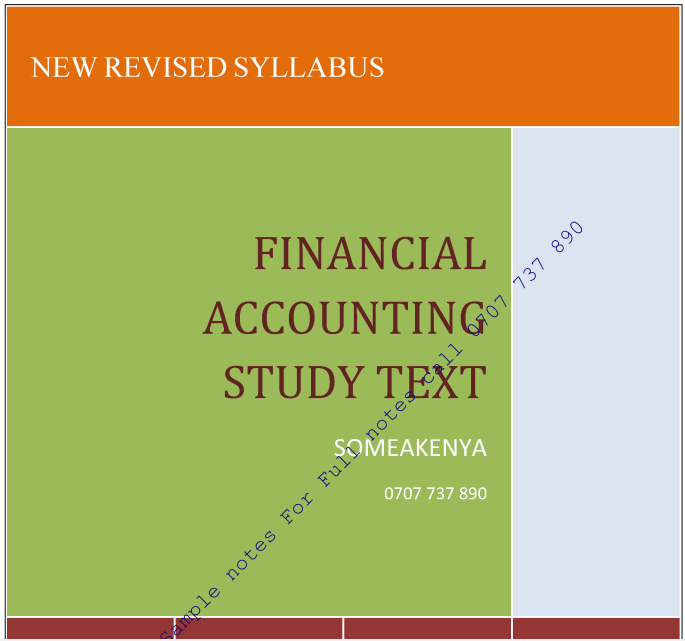
SomeaKenya provides Updated and Revised notes for the current CPA syllabus. Revision kits (Past papers with answers) are also available to help you with revision of the upcoming exams. You can get these materials in Hardcopies (Printed and Binded) and also available in Softcopy form when you subscribe on mobile or Desktop/Laptop someakenya Application. (Note: Softcopies are not Printable and can only be read using android phones) Click here to download SOMEAKENYA APP from Google Playstore.
Full Access to these notes/Kit on Desktop/Laptop via https://desktop.someakenya.co.ke
Or through Our Mobile App













Full Access to these notes/Kit on Desktop/Laptop via https://desktop.someakenya.co.ke
Or through Our Mobile App
1. Introduction to Accounting
- Nature and Purpose of Accounting
- The objective of Financial Accounting
- The Elements of Financial Statements
- The Accounting Equation
- The Users of Accounting Information
2. The Accounting Process and Systems
- The Source documents such as receipts and invoices
- The Books of Prime entry/Original Entry from the journals, cashbooks, Petty cash books and registers
- The Ledger and the concept of double entry
- The Trial Balance
- The Financial Statements
3. Regulation and other principles guiding the accounting profession
- The legal sources of regulation
- The professional sources of regulation (local and international bodies) and ethical requirements
- Accounting Standards
- Common accounting principles/concepts
- Qualities of useful financial information
4. Accounting for Assets and Liabilities
- Property, Plant and Equipment (depreciation, acquisition, disposal, exchange, excluding revaluations)
- Intangible Assets
- Financial Assets and Financial Liabilities (Definition, Examples and Classification only)
- Inventory
- Cash in hand and cash at bank (bank reconciliation statements)
- Trade Receivables (Measurement and credit Losses)
- Trade payables
- Accrued Incomes/Expenses and Prepaid Incomes/Expenses
5. Financial Statements of a sole trader
- Statement of Profit or Loss
- Statement of Financial Position
6. Financial Statements of a partnership
- The partnership deed/agreement
- The statement of Profit or Loss and appropriation
- Partners’ capital and current accounts
- The statement of financial position
- Accounting treatment and presentation when there is a change in profit/loss sharing ratio, admission/retirement of a partner, dissolution of a partnership
7. Financial Statements of a company
- Important concepts of a company (Ordinary and Preference share capital, issuing new shares by way of full market price, bonus shares and rights issue, Reserves, retained profits and corporation tax)
- Statement of Profit or Loss
- Other comprehensive incomes
- Statement of Financial Position
- Statement of Cash flows
8. Financial Statements of a manufacturing entity
- Manufacturing Statement of production
- Statement of Profit or Loss
- Statement of Financial Position
9. Statements of a not-for-profit entity
- Objectives of Not-for-profit organisations
- Statement of Income and Expenditure
- Statement of Financial Position
10. Correction of errors and preparing financial statements with incomplete records
- Types and causes of errors
- Correcting errors in source documents, the books of prime entry, the ledger, the trial balance and financial statements
- Reasons for incomplete information
- Preparation of financial statements from incomplete information
11. Analyzing Financial Statements
- The objective of analysing financial statements
- Analysing financial statements using financial ratios (Liquidity, Profitability, Solvency, Efficiency, Investor/Value and Cash Flow categories)
12. Accounting in the Public Sector
- Features of public sector entities (as compared to private sector)
- Structure of the public sector (National and county governments, State Corporations, Departments and Agencies)
- Regulation and oversight (International Public Sector Accounting Standards Board, Director of Accounting Services, National Treasury, Parliamentary Committees, Accounting Officers at national and county levels)
- Objectives of public sector financial statements and Standards (IPSAS)
- Accounting techniques in public sector such as budgeting, cash, accrual, commitment and fund accounting)
I need the notes kindly
The notes are quite good.
Hello
Kindly send me the notes in my email.
Hello
Kindly send me the notes to my email
Hello! l am interest in this note..
kindly send to my email.